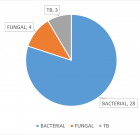Table of Contents
Produce starch-based bioplastic from different renewable biomass sources
Published on: 28th December, 2022
Due to the adverse environmental impacts of synthetic plastics, biodegradable plastics development for both industrial and commercial applications is essential for the present scenario. In addition to the non-degradability of petroleum-based plastic and its impacts, so it is very important to find an alternative to petroleum-based plastic. Starch-based bioplastics are an excessive substitute for petroleum-based plastics due to their significant properties compared with natural sources. This research aims to formalize five new formulas of bioplastic by combining two sources of starch, extracted from various biomass sources, its properties and comparison between them. The moisture content shows 2.07% and 0.984% for samples F and B respectively and that indicates that the samples which contain a high amount of corn starch have less moisture content. The highest results of biodegradation percentages were 68.27% and 52.6% which are for samples A and D respectively, and the lowest biodegradation percentage were 34.33% and 31.29% which are for samples F and B respectively.
Prevalence of Hypertension in patients with chronic Coronary Artery Disease in Cyprus
Published on: 6th December, 2022
Coronary Artery Disease (CAD) is the most common type of heart disease and a major cause of mortality worldwide. This study highlights the significance of hypertension as a risk factor in patients with CAD and compares its prevalence to those of EUROASPIRE IV (EUS-IV), ESC Atlas of Cardiology (Atlas) and Cyprus Survey of Coronary Heart Disease of 2006 (CY-2006). A retrospective, observational study was conducted, by the Registry of Cyprus Heart Survey, where 375 individuals with chronic CAD were examined in Nicosia General Hospital Cardiology Clinics, between the years 2011 and 2014. Their medical history regarding hypertension was noted and the data was analyzed using Microsoft Excel software. The total prevalence of hypertension, based on the past medical history of the patients was 59%.Out of these, 52% were found to have elevated blood pressure on their visit to the Cardiology Clinic. The total mean systolic blood pressure amongst the study group was 136 mmHg, with no significant differences between males and females (136 mmHg and 134 mmHg respectively).The findings of the present study are the same compared to those of the CY-2006 (52% both), but slightly higher than the findings of EUS-IV (52% vs. 42.7%) and significantly higher than those recorded in the Atlas (52% vs. 24.8%). The results show that there is still much potential to improve hypertension management in patients with established CAD.
Left ventricular hypertrophy linked with arterial hypertension through centralized aerobic-anaerobic energy balance compensation theory
Published on: 26th October, 2022
We demonstrated intrinsic connections between left ventricular hypertrophy (LVH) and arterial hypertension (AHT) through the recently announced centralized aerobic-anaerobic energy balance compensation (CAAEBC) theory. CAAEBC has already demonstrated achievements in the treatment of AHT, diabetes myelitis (DM), and osteochondrosis. Such demonstration lifts the necessity to check the applicability of this theory to other non-communicable diseases (NCDs) and develop the proper way to model the main idea of CAAEBC.
The risk of coronary heart disease varies with blood pressure grades and glycemic metabolism statues in a hypertensive
Published on: 30th August, 2022
Coronary heart disease (CHD) is the leading cause of death worldwide [1]. In China, the prevalence of CHD has kept continually increasing, with the number of patients being approximately 11.39 million, at present [2] and CHD poses a substantial threat to human health. Hypertension and diabetes both are the major risk factors for CHD [2,3] and the risk of CHD in patients with coexisting hypertension and diabetes is higher than that in patients with either of the two diseases [4].
Incidence and features of heparin-induced thrombocytopenia in mechanical heart valves and immunologic cardiac diseases
Published on: 5th January, 2022
OCLC Number/Unique Identifier: 9391755940
Background: Heparin-induced thrombocytopenia/thrombosis (HIT/T) is characterized by a fall in platelet count 5-10days after starting heparin therapy and is diagnosed with specific 4-T clinical features and laboratory tests. This complication is relatively common in Cardiothoracic surgery patients. Objective: To evaluate the positive and negative predictive value of various HIT laboratory tests and assess any correlation between HIT, the underlying diagnosis, underlying procedure, and mechanical cardiac devices. Patients and methods: The patient’s medical records were correlated with two laboratories HIT diagnostic tests, the pan-specific screening test with IgG, IgA, and IgM antibodies, followed by HIT specific IgG ELISA. Results: Total n = 80 patients were assessed, 48% (n = 38) were HIT screen pan-specific negative and 50% (n = 40) were HIT pan-specific positive and 2 cases were inconclusive. 17% (n = 14) were both pan-specific and specific HIT IgG ELISA positive. There were 5 atypical cases. One patient had Eosinophilic myocarditis and was HIT ELISA IgG neg. Argatroban was given on clinical grounds with successful recovery. One patient with Sarcoidosis had an aggressive course and received IV Immunoglobulin (IVIG) but succumbed secondary to liver failure. One patient progressed to gut ischemia and had surgical intervention but succumbed. Two patients with mechanical heart valves were on Argatroban but relapsed and responded to IVIG therapy. Conclusion: Our study indicates that 9/16 (> 50%) HIT-positive patients had valve replacement or cardiac devices suggesting that like knee arthroplasty there is a high incidence of HIT in patients with mechanical heart valves and cardiac devices and this warrants further prospective study.

HSPI: We're glad you're here. Please click "create a new Query" if you are a new visitor to our website and need further information from us.
If you are already a member of our network and need to keep track of any developments regarding a question you have already submitted, click "take me to my Query."



















































































































































